[四国EPO・四国ESDセンターが、みなさんにおすすめしたい!と思った事例をご紹介していきます]
第6回四国環境パートナーシップ表彰/ 6th Shikoku Environmental Partnership Award/ 第六届四国环境伙伴关系表彰
今回が6回目の開催となる四国環境パートナーシップ表彰では、「ESD人材育成部門」と「地域課題解決部門」において募集を行いました。
審査委員による書類選考の結果、5団体のファイナリストが選出、表彰式での活動発表を経て、パートナーシップ大賞、優秀賞が決定しました。
※下記、部門、都道府県、五十音順記載
■パートナーシップ大賞(地域課題解決部門)
活動名:黒潮薪本舗プロジェクト
団体名:株式会社 相愛(高知県)
■優秀賞(地域課題解決部門)
活動名:南予地域エコツーリズム推進協議会(準備会)
団体名:愛媛ダイビングセンター(愛媛県)
■優秀賞(地域課題解決部門)
活動名:3R貝絵アートコンテスト・展示会(施設展示とWeb展示)
団体名:NPO法人スペースゆう ともの会(愛媛県)
■優秀賞(地域課題解決部門)
活動名:生物多様性構内外育成保護活動
団体名:東芝ライテック株式会社 今治事業所(愛媛県)
■優秀賞(ESD人材育成部門)
活動名:「木育」をとおした持続可能な森林環境・資源づくりと活用への取組み
団体名:株式会社フォレストバンク(徳島県)
団体からの活動発表では、それぞれの取組の中で、足りないところを補い合い、他団体と役割分担しながら、活動を展開している事例も多く、協働の拡がりを実感する機会となりました。
その後、EPO東北の協力を得て、ケンタロ・オノ氏による講演をいただきました。
キリバスは地球温暖化により、多大な影響を受けているというお話の中で、何が起こっているかを知ることや、一人一人の小さな意識や行動の重要性を力強く、かつ、熱いメッセージとともに伝えてくださいました。
活動を行う団体同士が集り、学びあいを深めることができたことに加え、地域や世界のつながりを実感し、今後の活動の原動力にもつながる場となりました。
四国EPOでは、今後も皆さんの活動を発信等を通じて応援していきたいと考えています。
■6th Shikoku Environmental Partnership Award
At the 6th Shikoku Environmental Partnership Award, this year’s categories were ESD Human Resource Development and Regional Issue Resolution.
After being screened by judges, five organizations were selected as finalists, and the Partnership Grand Prize and Excellence Awards were given after their presentations at the ceremony.
※The list below is ordered by category, then prefecture, then alphabetical order
■Partnership Grand Prize (Regional Issue Resolution)
Activity Name: Kuroshio-makihonpo Project
Organization Name: Soai Inc. (Kochi)
■Excellence Award (Regional Issue Resolution)
Activity Name: Nanyo Ecotourism Promotion Council
Organization Name: Ehime Diving Center (Ehime)
■Excellence Award (Regional Issue Resolution)
Activity Name: The 3R Art Contest and Web Exhibition
Organization Name:NPO Space-U Tomonokai (Ehime)
■Excellence Award (Regional Issue Resolution)
Activity Name: Internal and External Biodiversity Conservation
Organization Name: Toshiba Lighting & Technology Corporation, Imabari branch (Ehime)
■Excellence Award (ESD Human Resource Development)
Activity Name: Efforts to create and utilize sustainable forest environments and resources through wood use education
Organization Name: Forest Bank Co., Ltd. (Tokushima)
Throughout the presentations, there were many examples of the organizations collaborating with other organizations to cover their weaknesses and expand their activities while sharing their roles to make a win-win relationship. It was a good opportunity to see the spread of cooperative action.
Then we had a keynote speech by Kentaro Ono with help from the Tohoku Environmental Partnership Office. On the topic of the Republic of Kiribati receiving a big impact from global warming, he spoke strongly and passionately about how important it is to know whats happening and that making small changes to awareness and behaviors can make a big difference. Gathering and learning from each other, but also fully realizing the connection between local and global makes those organizations empowered.
We at Shikoku EPO would like to continue spreading the word about all these activities and more like them in the future.
■第六届四国环境伙伴关系表彰
在第六届四国环境伙伴关系表彰上,「ESD人力资源开发部」和「区域问题解决部」进行了招聘。
根据评审团成员的筛选结果,5个组织的入围者在颁奖仪式上宣布了他们的活动,并获得了伙伴关系大奖和优秀奖。
※下记、部门、都道府县、五十音顺记载
■伙伴关系大奖(区域问题解决部门)
活动名称:黑潮薪本铺项目
团体名称:株式会社相爱(高知县)
■优秀奖(地域课题解决部门)
活动名称:南予地区生态旅游促进委员会(筹备委员会)
团体名称:爱媛潜水中心(爱媛县)
■优秀奖(地域课题解决部门)
活动名称:3R贝类艺术竞赛和展览(设施和网络展览)
组织名称:NPO空间亲友会(爱媛县)
■优秀奖(地域课题解决部门)
活动动名:生物多样性构内外培育保护活动
组织名称:东芝莱泰克株式会社 今治事业所(爱媛县)
■优秀奖(ESD人力资源开发部门)
活动名称:”通过树木培育”创造和利用可持续森林环境和资源的举措
组织名称:株式会社森林银行(德岛县)
在团体活动的发表中说到,在进行各项活动的过程中互相努力弥补不足,并与其他组织分担工作的同时开展活动的例子也不少,我们有机会感受到协同合作在扩大。
之后,在东北EPO的协助下,听到了健太郎·小野先生的演讲。
是关于基里巴斯受到全球变暖而受到巨大影响的故事,在演讲中了解到了基里巴斯发生了什么,并强烈的传达了每个人的小意识和行动的重要性。
除了能够让从事活动的组织聚集在一起,加深学习,我们认识到了社区和世界之间的联系,这将成为推动今后活动的原动力。
四国EPO希望继续通过传播等方式支持大家的活动。
ジオの鼓動と人と地域をつなぐ拠点 足摺宇和海国立公園竜串ビジターセンター「うみのわ」/ A Base Connecting People, Communities, and the Pulse of the Earth: Ashizuri Uwakai National Park Tatsukushi Visitor Center “Uminowa”/ 连接地理的心跳和人与社区的基地 足摺宇和海国立公园龙串游客中心「海之和」
高知県の西南、土佐清水市竜串に足摺宇和海国立公園竜串ビジターセンター「うみのわ」が2020年3月に設置されました。ここでは、この地域の特色ある自然や文化を伝え、次世代につなげる拠点としてさまざまな活動を行っており、次の5つの基本的機能があります。
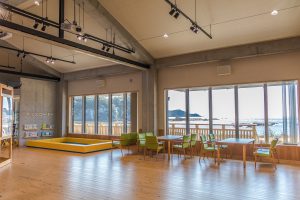 ・つ ど う:気軽に集い語り合う場の提供
・つ ど う:気軽に集い語り合う場の提供
・つたえる:情報発信や体験プログラム等による学びの場
・いざなう:地域の自然・文化との出会いをつなぐ
・しらべる:調査・研究への支援
・つ く る:人と人をつなぎ、多様性を活かした新たな価値を創造する
この地域は、大地の隆起・風化侵食でできた壮絶な姿を観察できる場所となっています。かつて日本列島は大陸の一部でした。この地域の大地の大部分は、このころに海底で積もった砂や泥がプレートの動きによって陸に押しつけられてできた地層が隆起してできています。
竜串海岸ではその後日本列島が大陸から離れ現在の位置に移動するころに、頻発していた地震や海底地すべりによってぐにゃぐにゃになった地層を見ることができます。地下ではマグマが大地を持ち上げ、やがて足摺岬を形づくり、現在の姿になりました。
竜串海岸では、大地の変動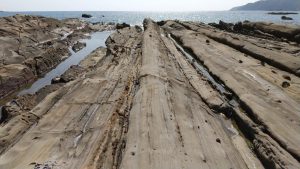 や生きものの痕跡、自然の営みが創りだした奇岩がたくさんあります。すぐにでも海岸に行きたいところですが、まず「うみのわ」でこの地域の森里川海の情報を入手することをお勧めします。
や生きものの痕跡、自然の営みが創りだした奇岩がたくさんあります。すぐにでも海岸に行きたいところですが、まず「うみのわ」でこの地域の森里川海の情報を入手することをお勧めします。
展示を見る、触るだけでなく、スタッフから展示の説明を聞いてみましょう。森から海への繋がり、暮らし、産業などがこの地域の自然と密接に関連していることが立体的に感じられ、大地のドラマとともに知的好奇心を掻き立てます。
美しい景色を写真に撮るだけでなく、ぜひ一つひとつに大地のドラマとそこに生きた生物にも思いをはせてもらいたいものです。
例えば、コンクリーションという茶色く酸化した丸い塊は、生きものの遺骸の成分が化学反応を起こしてできたとのこと。海岸のあちこちの岩にくっついており、不思議な光景となっています。それを「うみのわ」では手に持ち、重さを実感することができます。なんと、火星にも似たものがあるとのことで、思いは他の惑星の生きものの存在にも広がります。
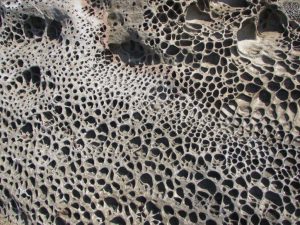 また、スナモグリが作った巣穴が化石となったものや、砂岩にしみ込んだ海水が乾いて結晶化することで岩に丸い穴をあけ(タフォニ)、それが連なることでレース状となったもの、水の動きが波模様となって残った漣痕(リップルマーク)など、自然がつくる妙に興味は尽きません。
また、スナモグリが作った巣穴が化石となったものや、砂岩にしみ込んだ海水が乾いて結晶化することで岩に丸い穴をあけ(タフォニ)、それが連なることでレース状となったもの、水の動きが波模様となって残った漣痕(リップルマーク)など、自然がつくる妙に興味は尽きません。
その他、「うみのわ」周辺には、貝殻やサンゴでできた砂浜や、豊かな海の生態を学べる足摺海洋館「SATOUMI」、サンゴや海底の生き物を観察できるグラスボート、気軽に海中が見える足摺海底館、貝殻を集めた海のギャラリー、キャンプ場など、この地域の「知りたい」「体験したい」に応える施設がたくさんあります。
過去のことを知り、地域の大地や気候、生態系、そして森里川海の繋がりが私たちの今の暮らしと産業・文化につながっていることに気づくことで、これからの私たちの暮らし方や未来の姿の方向に思いをはせることが出来るのではないでしょうか。
「うみのわ」では、自然ガイドや観光コンシェルジュをはじめとする様々な専門性を持ったスタッフによって、遊びや学び、体験をサポートしてもらえます。また、20名ほどで集い、学びあう交流の場として利用することもできます。ぜひ、竜串の自然を体験する拠点として活用してみてください。
足摺宇和海国立公園竜串ビジターセンター うみのわ
〒787-0450 高知県土佐清水市三崎4032-2
mail:uminowa◎tosashimizu-geo.jp(メール送信の際は、◎を@にご変更ください。)
■A Base Connecting People, Communities, and the Pulse of the Earth: Ashizuri Uwakai National Park Tatsukushi Visitor Center “Uminowa”
Ashizuri Uwakai National Park Tatsukushi Visitor Center “Uminowa” was established in March 2020 in Tatsukushi, Tosa Shimizu, in southwest Kochi. It has five basic functions to teach the next generation about the area’s unique natural features and culture:
・Gathering: It offers a place for casual conversation
・Informing: Providing a place to learn through information sharing and workshops.
・Inviting: Making connections with local nature and culture
・Investigating: Surveying and supporting research
・Creating: Connecting people and making new value with diversity
In this place, you can observe the rugged majesty of land shaped by upheaval and weathering. The Japanese islands were once a part of the mainland. Most of the land here was formed at that time, by the upheaval of the layers created by plate tectonics squeezing the mud and sand at the bottom of the sea against the land.
At the Tatsukushi coast, you can see the twisted geological strata created by the frequent earthquakes and underwater landslides that occurred when Japan broke away from the mainland and moved to its current position. Magma lifted the land eventually forming Ashizuri cape, and giving the area its current form. There are many strange rocks made by natural activity, movement of the earth and traces of living things. Though you may be tempted to rush straight to the coast, I recommend going to Uminowa first to get information about the area.
While you are there, don’t just look at and touch the exhibits, ask the staff for an explanation too. You’ll be able to get a threedimensional feel of things closely related with the area’s nature, such as the connection between the forest and the ocean, people’s lives, and industry. Your intellectual curiosity will be roused along with the drama of the earth.
Of course, you’ll want to snap pictures of the beautiful scenery, but I hope you also take the time to really think about the drama of the land and all the things that lived on it.
For example, brown oxidized round lumps called concretions were formed when the components of organic remains undergo a chemical reaction. These lumps dot the coast, stuck to other rocks, making for a mysterious sight. At Uminowa you can hold them in your hand and feel their weight for yourself. Learning that something similar exists on the surface of Mars might just open your mind to the possibility of life on other planets. The fossilized tunnels dug by mud shrimp. The lace-like pattern of tafoni clusters, formed when seawater soaks into sandstone and dries, crystalizing and opening up round holes in the stone. The ripple marks created by the movement of the water. Rarities of nature like these are sure to capture your interest!
On top of that, the area around Uminowa is full of places to check out if you want to learn more about the region and experience what it has to offer. You can enjoy sandy beaches formed from seashells and coral. At the Ashizura Aquarium SATOUMI, you can learn about the ecology of Tatsukushi Bay and the surrounding ocean. There are glass-bottomed boats you can ride to observe the coral and creatures living on the seafloor. Or, see them up close from the Ashizura Seabed Museum. There is also a gallery that displays gathered seashells, and a camp site!
By learning about the past, and being aware of how the region’s land and climate, ecology, and the connection between forests and the ocean all affect our current lifestyle, industry and culture, we can reevaluate our way of life and how we should shape our future.
At Uminowa, visitors can receive support in their play, learning, and experiences from staff with various specialties, including nature guides and sightseeing concierges. Additionally, groups of around 20 people can use the facilities as a space to gather and learn from each other. I sincerely hope you are able to use it as a base to experience the nature of Tatsukushi.
Ashizuri Uwakai National Park Tatsukushi Visitor Center “Uminowa”
4032-2 Misaki, Tosashimizu, Kochi 787-0450
e-mail:uminowa◎tosashimizu-geo.jp (When you send an e-mail, please replace the ◎ with @)
■连接地理的心跳和人与社区的基地 足摺宇和海国立公园龙串游客中心「海之和」
2020年3月在高知县西南部,土佐清水市龙串足摺宇和海国立公园设置了龙串游客中心「海之和」。在这里,传达该地区独特的自然和文化,并与下一代联系起来,开展着各种活动,其具有以下五个基本功能:
・聚集:提供一个轻松聚会和讨论的地方
・传达:通过信息传播和体验学习的地方
・紧急情况:与当地自然和文化建立联系
・调查:支援调查和研究
・创造:连接人与人,利用多样性创造新的价值
该地区是,观察大地隆起和风化侵蚀而形成的壮观景象的地方。日本列岛曾经是大陆的一部分。在这个地区的大部分地方,沙子和泥浆堆积在海底,因为板块的运动挤压在陆地上形成了凸起的地层。
在龙串海岸,当日本列岛离开大陆并移动到现在的位置时,可以看到频繁的地震和海底滑坡而形成的地层。在地下,岩浆抬起了大地,最终形成了足摺岬,成为现在的样子。
在龙串海岸,有许多由大地的变化,生物的痕迹和自然活动而形成的奇岩。如果想马上去海滩,则先建议你通过「海之和」先获取有关该地区森里川海的信息。观看和触摸展品,并听取工作人员对展品的说明。从森林到海洋的连接,可立体的感受到生活和工业与该地区的自然有着密切的相关,会极大的激起你的好奇心。
我们希望不仅拍摄到美丽的风景,还希望人们欣赏大地的鬼斧神差和在那里生活的生物。
例如,一个棕色的因氧化而形成的球型的凝固物,据说是生物的遗骸成分经过引起化学反应而形成的。它粘在海岸上的岩石上,是一个不可思议的景象。在「海之和」,你可以把它握在手里,感受它的重量。据说火星也有类似的东西,让人觉得其他星球上也存在生物。
还有,虾爬的巢穴成为化石,浸入砂岩的海水经过干燥结晶在岩石上形成圆型的小洞(塔福尼),那些小洞连成一串形成蕾丝状,水的运动成为波浪而留下的痕迹(波纹标记)等,自然的创造妙不可言。
此外,在「海之和」周围,有由贝壳和珊瑚形成的沙滩,可以学到丰富海洋生态的足摺海洋馆「SATOUMI」,一艘可以观察珊瑚和海底生物的玻璃船,一个可以随意看到海洋的足摺海底馆,一个收集贝壳的海洋画廊,露营地,有许多可满足该地区的「想知道」和「我想体验」的设施,。
通过了解过去,并认识到当地的气候、生态系统和森里川海之间的联系与我们目前的生活、工业和文化息息相关,让我们思考今后的生活方式和未来要走的方向。
在「海之和」有各种专业知识的员工,包括自然导游和旅游礼宾人员,可以协助您的游览、学习和体验。此外,「海之和」也可作为20人左右聚在一起相互学习和交流的场所。希望大家把它作为体验龙之串的自然基地来活用。
足摺宇和海国立公园龙串游客中心「海之和」
787-0450高知县土佐清水市三崎4032-2
邮件:uminowa◎tosashimizu-geo.jp ◎→@
ゴミを出さない暮らし方を目指した新たなチャレンジ ―上勝町ゼロ・ウェイストセンター「WHY」―/ Recommitting to the Challenge of a Life Without Garbage: Kamikatsu Zero Waste Center “WHY”/ 不出垃圾的生活方式为目的的新的挑战:上胜町零垃圾中心「WHY」
徳島県上勝町は、2003年に自治体として日本ではじめてゼロ・ウェイスト宣言を行い、ゴミを45分別していることで有名です。「2020年までにゴミをゼロにする」という目標を掲げ取組を進め、リサイクル率80%を達成しました。昨年、その目標年を迎え、2030年を次期目標年とした、新たなゼロ・ウェイスト宣言が、昨年12月18日に議会の全会一致で可決されました。新たな宣言の重点目標には、「未来のこどもたちの暮らす環境を自分の事として考え、行動できる人づくり」が掲げられ、3つの取組を進める計画です。
1 ゼロ・ウェイストで、私たちの暮らしを豊かにします。
2 町でできるあらゆる実験やチャレンジを行い、ごみになるものをゼロにします。
3 ゼロ・ウェイストや環境問題について学べる仕組みをつくり、新しい時代のリーダーを排出します。
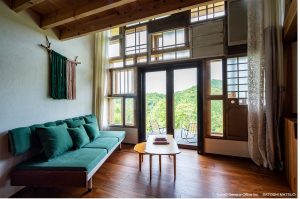
新たな宣言の達成に向けた取組の拠点となる場所が、2020年4月にオープンした上勝町ゼロ・ウェイストセンター「WHY」です。施設は、上空から見ると「?」の形になっています。町内外から集めた、使われなくなったソファやドア、窓等を使って建てられ、施設を解体するときにゴミにならないよう工夫もされています。
新たな施設には、旧施設にもあった、町内唯一のゴミステーション、ストックヤードと、まだ使える商品が次のオーナーと出会う場となる「くるくるショップ」の他、新たにイベントや研修に使えるホール、町民の要望で設置されたコインランドリー、企業や研究者等との協働を目指したオフィス・ラボと、ゴミを出さない暮らし方を体験するホテルも設置されました。
「WHY」では、利用者にどうしたらゴミが出ない暮らしができるかを考える場づくりや、どうしてもリサイクルできない2割のゴミを企業や研究者と連携して解決する取組等、ゼロ・ウェイスト達成に向けた仕組みづくりや仲間づくりといった、新たなアプローチに力を入れています。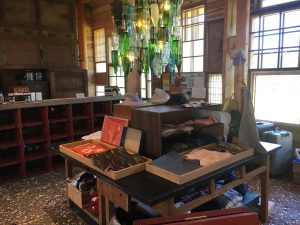
なぜそれを買うのか?なぜそれを捨てるのか?なぜそれを作るのか?なぜそれを売るのか?自分の行動に対して「なぜ(WHY)?」と問いかけるところから始めてみてはどうでしょうか。
■ZERO WASTE TOWN Kamikatsu
https://zwtk.jp/
■上勝町ゼロ・ウェイストセンター「WHY」
https://why-kamikatsu.jp/index.html
■Recommitting to the Challenge of a Life Without Garbage: Kamikatsu Zero Waste Center “WHY”
Kamikatsu, Tokushima was established in 2003 as Japan’s first “zero waste” town, and is famous for sorting its garbage into 45 different categories. While striving toward the goal of becoming fully zero waste by 2020, it achieved a recycling rate of 80%. Last year, the target year was reached, and on December 18 the town assembly unanimously approved a new Zero Waste Declaration with a target year of 2030. The primary goal of this new declaration is to cultivate people who can think about the
environment that future generations will live in as their own, and act accordingly. Therefore, the town will advance three measures:
1. Enrich our lives with zero waste
2. Enact every experiment and challenge possible as a town, and reduce the number of things that can become garbage to zero.
3. Create a system to study waste-free practices and environmental problems, and produce leaders for a new era.
To help accomplish this new goal, the Kamikatsu Zero Waste Center “WHY” was opened in April 2020. Viewed from the air, the facility has the shape of a question mark. It was built using disused sofas, doors, windows and other materials from in and out of town, and was specially designed so that it won’t become garbage when it is eventually dismantled.
Just like the old facility, the new facility contains the town’s sole garbage collection station, a stockyard, and the “Kurukuru Shop” where still-usable goods can meet their next owners. However, in addition to that it also has a hall that can be used for events or training, a coin-operated laundromat requested by the citizens of the town, offices and laboratories to facilitate cooperation with businesses and researchers, and a hotel where visitors can experience a garbage-free lifestyle.
By encouraging people to think about how they can live without creating garbage and working together with companies and researchers to solve the problem of the 20% of waste that can’t be recycled, WHY is focusing its efforts on new approaches to achieving Zero Waste.
Why buy that? Why throw that away? Why make that? Why sell that? The key to changing the future lies in reflecting on one’s own actions and asking one simple question: “WHY”.
■ZERO WASTE TOWN Kamikatsu
https://zwtk.jp/
■Kamikatsu Zero Waste Center “WHY”
https://why-kamikatsu.jp/index.html
■不出垃圾的生活方式为目的的新的挑战:上胜町零垃圾中心「WHY」
德岛县上胜町,2003年作为地方政府首次宣布零垃圾和分45种垃圾而闻名。提出了「到2020年将垃圾降至零」的目标,并实现了80%的回收率。去年,新的零垃圾宣言宣布2030年为下一个目标年,并在12月18日的议会当天一致通过。新的宣言的重点目标是「培养能够思考未来儿童生活环境,并能行动的人」,此计划采取三项举措。
1 零垃圾可丰富我们的生活。
2 在城里做各种各样实验和挑战,把产垃圾的东西降为零。
3.建立学习零垃圾和环境问题的机制,并培养出新时代的领导者。
2020年4月开业的上胜町零垃圾中心是实现新宣言的基地「WHY」。从空中看,设施是像「?」。它使用了从城镇内外收集的不再使用的沙发、门和窗户建造,并设计了在拆除设施时不成为垃圾的方法。
新设施包括旧设施中唯一的垃圾站、货场和仍然可以使用的产品能与下一个业主见面的「循环商店」,以及可用于新的活动和培训的大厅、应居民要求安装的投币式自助洗衣店、旨在与企业和研究人员合作的办公室和实验室,以及体验不倒垃圾的生活方式的酒店。
在「WHY」中,创造了让用户思考如何过上没有垃圾的生活,与公司和研究人员合作解决不能回收利用的20%的垃圾。目前助力于建立实现零垃圾的机制和建立与同伴之间紧密关系。
为什么要买它?你为什么把它扔掉?为什么要做呢?为什么要卖它?为什么不从问「为什么(WHY)」开始你的行动呢?
■ZERO WASTE TOWN Kamikatsu
https://zwtk.jp/
■上胜町零垃圾中心「WHY」
https://why-kamikatsu.jp/index.html



